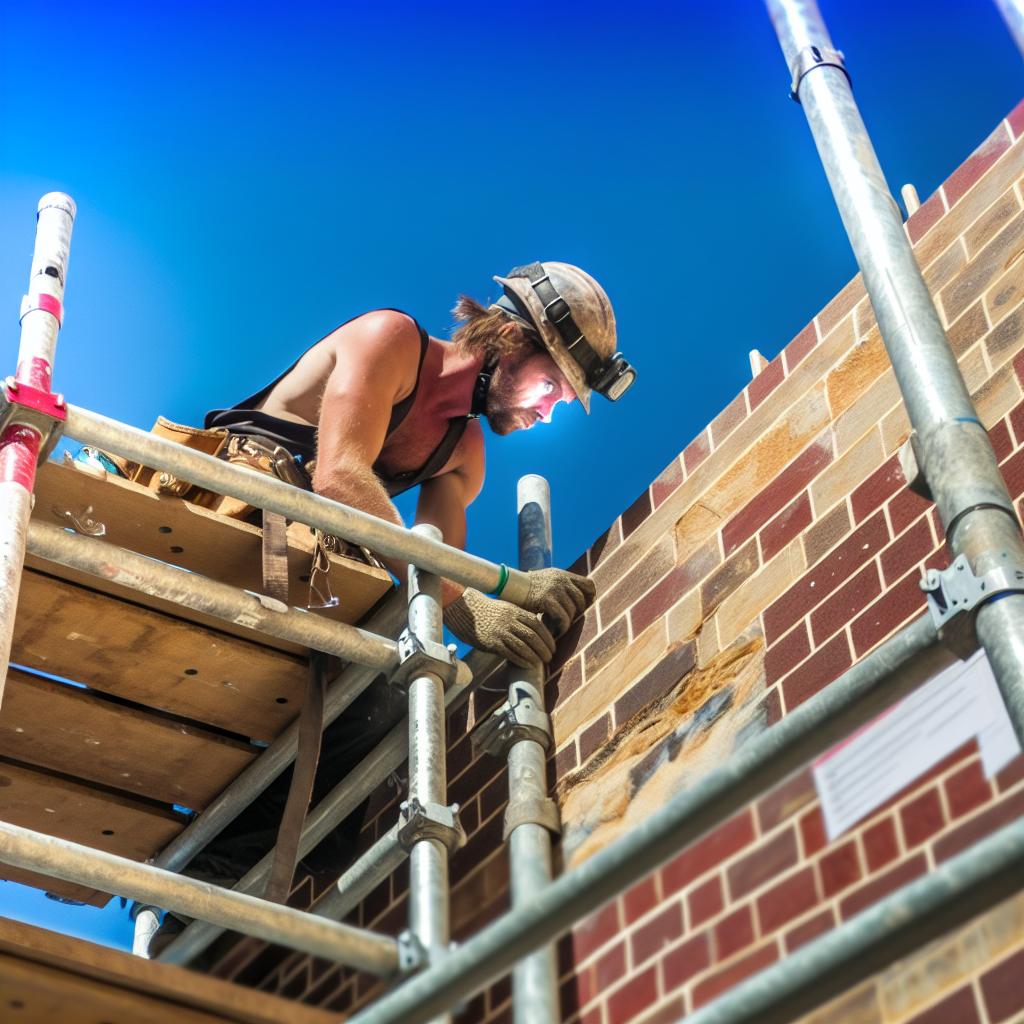Introduction to the Role of Scaffolders in the Construction Industry
Scaffolders are essential in the construction industry.
They provide platforms that support workers and materials.
Moreover, their work enhances overall safety on construction sites.
In addition, scaffolders ensure that tasks are completed efficiently.
Responsibilities of Scaffolders
Scaffolders have various responsibilities to uphold safety standards.
They must assemble scaffolding structures according to safety regulations.
Additionally, they inspect scaffolding for stability and security.
Furthermore, scaffolders work collaboratively with other tradespeople.
They communicate effectively to ensure safe working environments.
Importance of Safety Training for Scaffolders
Safety training is crucial for scaffolders in their daily tasks.
Proper training minimizes risks associated with scaffolding work.
Moreover, trained scaffolders can identify hazards early.
This proactive approach helps prevent accidents on site.
Regulations and Standards Governing Scaffolders
Scaffolders must adhere to strict regulations within the industry.
These regulations outline safety practices and procedures.
Your Personalized Career Strategy
Unlock your potential with tailored career consulting. Get clear, actionable steps designed for your success. Start now!
Get StartedCompliance guarantees the safety of all workers on site.
Additionally, it protects the integrity of the structures being built.
Collaboration Between Scaffolders and Other Trades
Scaffolders frequently collaborate with different construction teams.
They ensure scaffold access is available for various trades.
This collaboration improves workflow and project timelines.
Moreover, it fosters a culture of shared responsibility for safety.
Overview of Construction Safety
Construction safety is a fundamental aspect of the building industry.
This field focuses on protecting workers from accidents and injuries.
Construction sites pose various risks that can be hazardous.
Therefore, safety measures are crucial for a successful project.
Implementing safety protocols fosters a secure working environment.
Importance of Construction Safety
Ensuring safety benefits both workers and employers alike.
It helps to reduce the number of accidents on-site.
Moreover, lower accident rates can lead to higher productivity.
Stand Out with a Resume That Gets Results
Your career is worth more than a generic template. Let us craft a resume and cover letter that showcase your unique strengths and help you secure that dream job.
Get HiredWhen workers feel safe, they can focus on their tasks effectively.
Consequently, the overall project efficiency improves.
Common Risks in Construction
Construction sites present numerous potential hazards.
Some common risks include falls, equipment accidents, and electrocution.
Additionally, exposure to harmful materials can pose health risks.
Identifying these hazards is the first step toward safety.
Workers must be aware of their environment at all times.
Benefits of Safety Protocols
Implementing safety protocols can lead to significant advantages.
- Increased worker morale and confidence.
- Reduced insurance costs for accidents and claims.
- Enhanced reputation for the construction company.
- Compliance with legal and regulatory standards.
These benefits create a win-win situation for all stakeholders.
Key Responsibilities of Scaffolders in Ensuring Safety
Site Assessment and Planning
Scaffolders conduct thorough site assessments before installation.
They evaluate ground conditions and potential hazards.
Additionally, they plan the scaffold layout for optimal safety.
Effective planning reduces risks during construction activities.
Proper Scaffold Assembly
Scaffolders are responsible for assembling scaffolding systems correctly.
Transform Your LinkedIn for Maximum Impact
Elevate your professional brand with a LinkedIn profile that attracts recruiters, showcases your expertise, and maximizes opportunities. Stand out in your industry with a profile built for success.
Boost ProfileThey follow industry standards and manufacturer guidelines strictly.
Using proper materials ensures the scaffold’s integrity.
Furthermore, they implement safety features like guardrails.
Regular Inspections
Inspecting scaffolding is crucial for ongoing safety.
Scaffolders perform regular checks for structural integrity.
They look for any signs of wear, corrosion, or damage.
Additionally, they assess the surrounding environment for changes.
Communication and Training
Effective communication enhances safety on the job site.
Scaffolders share important safety information with the crew.
They also educate teams about scaffold usage and risks.
Regular training sessions reinforce safety practices.
Emergency Preparedness
Scaffolders develop emergency response plans for incidents.
They train crews on procedures to follow during emergencies.
Having a plan establishes quick, effective responses.
This preparedness minimizes the potential for injuries.
Gain More Insights: How Landscape Gardeners Enhance Australian Outdoor Spaces
Types of Scaffolding Systems and Their Impact on Safety Measures
Introduction to Scaffolding Systems
Scaffolding acts as a key support structure in construction sites.
It provides a safe working platform for workers at various heights.
Consequently, choosing the right scaffolding system is vital for safety.
Supported Scaffolding
Supported scaffolding is the most common type used in construction.
This system relies on a base or ground for support throughout its height.
For instance, frame scaffolding is a popular choice.
It offers stability and is easy to assemble.
However, proper installation and regular maintenance are critical.
Any misalignment can lead to accidents or falls.
Suspended Scaffolding
Suspended scaffolding hangs from an overhead structure.
This type is ideal for tasks like window washing or work on facades.
Additionally, it allows for flexible height adjustments.
However, safety precautions are essential to prevent falls.
Using safety harnesses and lines can mitigate risks effectively.
Rolling Scaffolding
Rolling scaffolding features wheels, allowing for mobility.
This type facilitates quick movement across the site.
It’s perfect for projects requiring frequent relocations.
Nevertheless, workers should ensure the locks are engaged before use.
Moreover, rolling scaffolds should be used on stable ground only.
System Scaffolding
System scaffolding features pre-engineered components for more extensive structures.
This allows for versatility and quick assembly.
Moreover, it provides multiple configurations, adapting to various site needs.
System scaffolding enhances stability and load-bearing capacity.
However, thorough training is essential for assembly and dismantling.
Safety Considerations for Different Scaffolding Types
Each scaffolding type affects safety protocols differently.
Efficient training on scaffold operations is crucial for all workers.
Certain systems may require specific protective gear and techniques.
Regular inspections of scaffolding are key to ensuring worker safety.
Identifying potential hazards can prevent serious injuries on-site.
Enhancing Worker Safety through Proper Scaffolding Practices
Scaffolding systems play a significant role in construction safety.
Choosing the right type and understanding safety measures is imperative.
Ultimately, proper implementation enhances the security of all workers.
Gain More Insights: The Role of Carpenters in Building and Restoring Australia
The Training and Certification Process for Scaffolders
Importance of Training for Scaffolders
Training is essential in the scaffolding industry.
It ensures safety and proper techniques during construction.
Moreover, trained scaffolders reduce the risk of accidents.
This process also helps in understanding materials and tools.
Certification Requirements
Certification is a critical step for scaffolders.
Candidates must complete a recognized training program.
These programs cover topics like safety regulations and equipment handling.
After training, scaffolders must pass a competency assessment.
Types of Training Programs
Various training programs exist for aspiring scaffolders.
Short courses focus on specific skills like assembly and disassembly.
Longer programs offer comprehensive education about scaffolding systems.
Online courses are also becoming increasingly popular.
Hands-On Experience
Hands-on experience is vital in the training process.
This practice allows scaffolders to apply learned concepts effectively.
It also teaches them to identify potential hazards on-site.
Hands-on training improves overall confidence in skills.
Continuing Education and Recertification
Continuing education is essential in the construction field.
It helps scaffolders stay updated on safety regulations.
Recertification is often required every few years.
This process ensures they maintain their skills and knowledge.
See Related Content: How Plumbers Keep Australia’s Infrastructure Flowing Smoothly

Common Safety Hazards Associated with Scaffolding
Understanding Scaffolding Risks
Scaffolding presents several safety hazards on construction sites.
Workers may face falls from height, which is a leading cause of injuries.
Improperly assembled scaffolds increase the risk of accidents significantly.
Moreover, workers can encounter falling objects if materials are not secured.
Poor visibility on construction sites can also contribute to accidents.
Falls from Height
Falls from scaffolding are common and often serious.
To mitigate these risks, proper guardrails should be installed.
Additionally, workers must wear appropriate personal protective equipment.
Using harness systems further protects employees working at heights.
Improper Assembly
Scaffolding must be assembled according to manufacturer guidelines.
Regular inspections by qualified personnel help ensure stability.
Training workers in scaffold assembly is critical for safety.
Documenting scaffold inspections can also enhance site safety practices.
Falling Objects
Objects falling from scaffolding pose significant hazards below.
Using tool lanyards can prevent tools from dropping.
Establishing exclusion zones keeps employees out of danger areas.
Properly securing all materials on scaffolding is crucial.
Poor Visibility and Weather Conditions
Poor visibility can increase the likelihood of accidents.
Workers should wear high-visibility clothing to improve safety.
During adverse weather, scaffolding should be assessed for safety.
Using additional lighting on site can help workers see better.
Mitigating Scaffolding Hazards
Regular Training and Education
Providing ongoing training helps workers understand scaffold safety.
Training should cover both assembly and safe usage practices.
Encouraging a culture of safety reduces overall risks on site.
Establishing Safety Protocols
Implementing clear safety protocols is essential for all workers.
Regular safety meetings can reinforce the importance of safety measures.
Creating checklists for scaffold inspections enhances compliance.
Using Quality Materials
Quality scaffolding materials minimize the risk of failure.
Regularly inspecting materials for signs of wear or damage is vital.
Only using certified materials from reliable suppliers ensures safety.
Monitoring and Enforcement
Supervisors should monitor scaffolding operations consistently.
Immediate corrective actions should take place for any safety violations.
Implementing a buddy system can enhance oversight and support.
Uncover the Details: Skilled Labor Shortages in Australia: The High-Demand Trades You Should Consider
Case Studies Highlighting Scaffolders’ Contribution to Successful Safety Outcomes
Effective Training Programs
Effective training programs ensure scaffolders are well-equipped for their roles.
For example, Highland Builders invested heavily in comprehensive training.
Employees reported increased confidence while working at heights.
This positive outcome led to a remarkable drop in accidents on-site.
Real-World Implementation
Case studies provide valuable insights into scaffolders’ safety strategies.
One notable example is the Skyline Plaza project.
Scaffolders implemented a tiered safety system for their scaffolding structures.
This system enhanced stability and reduced risks during construction activities.
Collaboration with Safety Inspectors
Collaboration between scaffolders and safety inspectors proves essential.
On the Riverside Bridge project, scaffolders and inspectors worked closely.
This collaboration ensured that safety standards were always adhered to.
As a result, the project saw zero safety violations recorded.
Feedback Loops and Accountability
Feedback loops enhance the safety culture among scaffolders.
For example, Horizon Builders established regular safety meetings.
During these meetings, scaffolders shared experiences and learned from each other.
This open dialogue fostered accountability and continuous improvement.
Innovative Safety Equipment
Innovative safety equipment plays a vital role in scaffolding safety.
The use of advanced harness systems significantly increased worker safety.
At the Grandview Hotel renovation, scaffolders utilized state-of-the-art gear.
This technology allowed for safer maneuvering at heights.
Long-Term Benefits of Safety Practices
Long-term commitment to safety practices yields numerous benefits.
Research shows that safe scaffolding practices reduce downtime significantly.
Additionally, companies with strong safety records attract better talent.
Ultimately, scaffolders contribute to a culture of safety that benefits everyone.
Future Trends in Scaffolding and Their Implications for Construction Safety
Innovative Scaffolding Materials
Innovative materials are shaping the future of scaffolding.
Reinforced plastics and lightweight metals improve safety and functionality.
These materials reduce weight while maintaining structural integrity.
As a result, workers can assemble and disassemble scaffolding efficiently.
Additionally, new materials often resist environmental factors better.
Integration of Technology
Technology is becoming integral to scaffolding systems.
Smart scaffolding incorporates sensors to monitor structural stability.
This real-time data enhances safety and responsiveness on-site.
Drones can now inspect scaffolding from the air with ease.
Furthermore, virtual and augmented reality aid in training workers effectively.
Sustainability Practices
Sustainability is a significant focus in modern scaffolding trends.
Recyclable materials are increasingly being utilized in scaffolding construction.
This shift reduces waste and promotes environmentally friendly practices.
Moreover, energy-efficient processes are being adopted to minimize carbon footprints.
Regulatory Changes and Compliance
New safety regulations are driving changes in scaffolding practices.
Compliance will focus more on ensuring worker safety at height.
Scaffolders will need to undergo regular training to stay updated.
Furthermore, stricter penalties for non-compliance will likely emerge.
Enhanced Safety Protocols
Enhanced safety protocols are crucial as construction sites evolve.
Regular safety audits will become standard practice across sites.
Additionally, scaffold users will need to wear personal protective equipment consistently.
Worksite safety meetings should occur frequently to discuss risks and solutions.
Additional Resources
Reinventing Construction: A Route to higher productivity Full Report …




